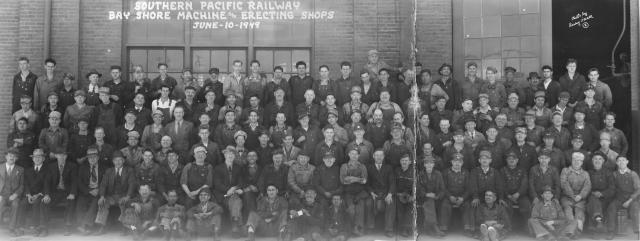By Jeremy Lipps, @Calif0rnio
Brisbane’s Bayshore Roundhouse was, at one point, part of a vast railroad complex at the center of Southern Pacific’s Bay Area activity. Built between 1907 and 1910, the Bayshore shops were the jewel of Southern Pacific’s “Coast Division” with more than 3,000 workers between 1911 and 1958. Its many employees brought local culture to the region through the founding of social and garden clubs and sports teams.
Built to service the constant needs of the Southern Pacific steam fleet, the roundhouse had 17 covered stalls. The area where the roundhouse, shops and switching yards were built was landfill created with debris from the 1906 San Francisco Earthquake and soil from the Bayshore cut. The facility eventually grew to contain a massive freight yard, a machine shop, a four-story erecting hall and even an employee hospital. The work being done at the Bayshore Roundhouse was cutting-edge. Crews were able to increase locomotive efficiency through an innovative procedure that involved “counter-balancing” the steam engine’s main drive wheels.
By adding large strips of steel to the drivers the engineers were able to stabilize the rotation thereby increasing efficiency. The Bayshore Roundhouse was built as part of a larger rail system that included a rerouting of the Peninsula railroad. The new route shaved two and a half miles off the original 1863 “mission” route. In addition to saving mileage, it also eliminated the need for helper engines that pulled every train over San Bruno Mountain at a 2 percent grade, thus saving on fuel and man-hours.

In 1941 the roundhouse’s original 90-foot turnplate was replaced by a longer 110-foot turntable. The steel for the new version was salvaged from the Pajaro River Bridge. It allowed the location to accommodate the largest locomotives operating at the time. As the steam era came to an end in 1958, the introduction of more reliable diesel locomotives triggered the decline of the roundhouse. After Southern Pacific stopped using steam locomotives the roundhouse was used to stable diesel engines. Crews were reduced steadily until, finally, on Oct. 25, 1982, the roundhouse was closed for good.
Today the roundhouse sits abandoned, owned by a private developer. It is covered in graffiti and was severely damaged in a 2001 fire. It was recently listed on the National Register of Historic Places, largely due to the work of Cris Hart, a train enthusiast and a restorer with San Francisco Trains. The roundhouse survives, along with the tender and tank building, now occupied by the Lazzari Fuel company.
Hart hopes to have the roundhouse restored one day to serve as the centerpiece of a new development. The roundhouse is on private property and entering is against the law. There are also known carcinogens on the property, including asbestos. But we invite you to enjoy photos taken when we were invited to the site with its current caretaker. The best place to safely view the roundhouse is from Caltrain's west side as the train heads South (toward San Jose) from the Bayshore station.
Other Bayshore Roundhouse Links: www.wx4.org (former S.P. and Caltrain engineer, E. O. Gibson) www.sanfranciscotrains.com flier PDF
